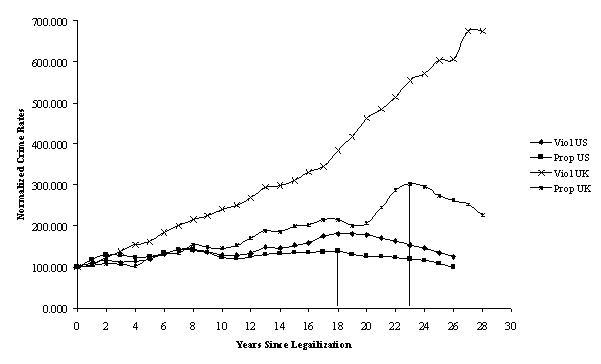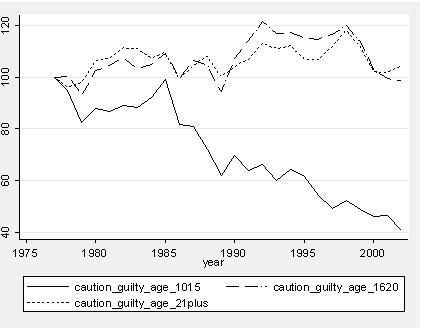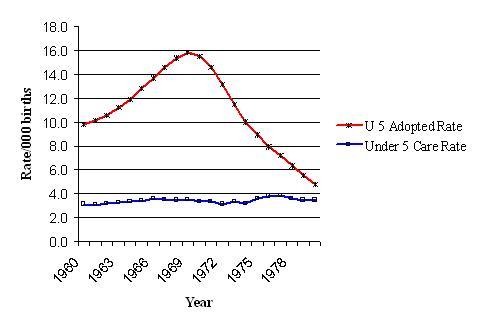The hypothesis that the legalisation of abortion contributed to a dramatic fall in crime rates in the United States, originally proposed by John Donohue and Steven Levitt in an article in 2001 and popularised by Levitt’s best selling book Freakonomics, has been the subject of close scrutiny by other academics. Until now, this scrutiny has focussed on issues of measurement and statistical specification, and there have been few serious attempts to test the Donohue and Levitt (henceforward D&L) hypothesis in countries other than the United States. In recent research, we analyse the impact of abortion on crime in England and Wales to attempt to rectify this gap in the evidence.1 Examining this question in the context of the UK is important for a number of reasons, not least of which is that, in contrast to the US, in the UK, abortions are subject to mandatory reporting and, as a result, data on (legal) abortions are complete and of high quality.
The first port of call in our analysis was to examine whether the timing of changes in crime in England & Wales was consistent with abortion having an impact. Figure 1 compares trends in two key crime categories in the UK and the US. The vertical lines on the figure indicate the point at which we can observe a decrease in at least one of the crime series. For the US (as noted by D&L), crime starts to fall about 18 years after the legalisation of abortion, consistent with abortion being a causal influence. In contrast, property crime in England and Wales starts to fall about 23 years after the first full year of abortion (1969), too late to be consistent with a causal effect. Violent crime does not decrease at all over the period.
Figure 1. Crime rates for U.S. and England & Wales since abortion legalisation
Source: Kahane, Paton and Simmons (2008). Data are indexed to be 100 for the first full year in which abortion was legalised (1973 for US, 1969 for England & Wales).
Several reasons might explain the different trends in crime in the two countries. One possibility is that abortion legalisation reduced crime in the US but not the UK. Alternatively, legalisation may actually have reduced UK crime, but other factors have swamped the time series relationship. Finally, legalisation may not have reduced crime in either country and the timing of the US crime fall is down to other factors.
A natural way of distinguishing these explanations is to examine whether crime fell more (or increased less) amongst those young enough to have been affected by abortion legalisation compared to those born before the legislation. Figure 2 shows the pattern of conviction rates for those aged 10-15, 16-20 and 21 plus in England and Wales. The trends are not supportive of a link between abortion and crime. Rates for the 10-15 age group decrease but only from 1985, probably too late to have been caused by abortion legalisation. Further the plots for the 16-20 and 21 plus categories show no downward trend and appear to move up and down together. For abortion legalisation to have an affect, we would predict that one plot would follow the other downwards. As authors commenting on D&L’s results have noted, a striking feature of the data from the US is that crime rates in the 1990s fell not only amongst younger age groups who would have been affected legalisation in 1973, but also amongst older age groups who could not have been affected by the change.2
Figure 2. Conviction rates by age in England and Wales
Source: Kahane, Paton and Simmons (2008)
Given all this, it seems highly unlikely that the legalisation of abortion can, as D&L hypothesised, explain the dramatic drop in crime observed in the US in the 1990s. However, we cannot necessarily conclude from this that abortion has no impact on crime. It is quite plausible that, even if legalising abortion does not reduce subsequent crime rates, marginal changes in abortion rates after legalisation may still lead to marginal changes in crime rates. In our analysis of England and Wales, we report panel regressions of recorded crime in different police force areas in which abortion rates appear to be negatively correlated with crime rates. D&L report a similar result using US state-level data.
Some recent work has cast doubt on the direction and statistical significance of D&L’s estimates of the marginal impact of abortion rates on crime rates.3 Similarly, the estimated impact of abortion for England and Wales is extremely sensitive to both the specification of the statistical model and the choice of crime dataset. These caveats notwithstanding, it is interesting to speculate why abortion and crime rates may be negatively related even if the legalisation of abortion itself does not reduce crime.
A potential explanation of this apparent conundrum arises from considering what actually happened to children who would not have been born had abortion been legal at the time of their conception. Some such children would have been brought up in adverse circumstances (either by the birth parent or by being taken into the care of the state) and may consequently have been at a higher risk of committing crime. On the other hand, other children conceived in similarly adverse circumstances would have been given up for adoption and then brought up in relatively stable and affluent circumstances. Put another way, prior to the legalisation of abortion, unwanted babies did not necessarily become unwanted children. If the main impact of abortion legalisation was to reduce the number of infant adoptions, we should scarcely expect the legalisation to reduce subsequent crime.
Figure 3 illustrates trends in rates of infant adoptions and children taken into state care in England and Wales between 1960 and 1980. The rate of children in care barely changes after abortion legalisation in 1968, whilst there appears to be a dramatic effect on adoptions. The rate of infants under five who had been adopted at birth decreased from 16 per thousand in the mid-1960s to about 5 per thousand just 10 years later. Rather than just reducing the number of unwanted children, abortion legalisation appears to have reduced the number of unwanted infants who would have ended up (through adoption) being wanted children.
Figure 3. Rates of children adopted and taken in care, England & Wales
Source: ONS Children in Care Statistics (various years)
What about the impact of marginal changes in abortion rates after legalisation occurred? It seems that the legalisation of abortion contributed to a structural shift in society from a situation in which it was normal to put “unwanted” infants up for adoption to one in which adoption was actively discouraged. Once this structural change occurred, it is plausible that, say, a subsequent marginal tightening of the abortion law will have two effects. Children conceived in adverse circumstances are (marginally) more likely to be born rather than aborted but are then more likely to be brought up in those same adverse consequences rather than being put up for adoption. If true, we will observe a negative link between abortion rates and subsequent crime rates.
Although speculative, this hypothesis is consistent with observed trends in adoptions and with the analyses of the abortion-crime link in both the US and the UK. The hypothesis suggests a natural way forward for researchers interested in the social impact of abortion. Rather than trying to identify a causal link from abortion to indirect outcomes such as crime which are only observed many years later, it may be more fruitful to try to tease out the size and direction of the impact of abortion on contemporaneous and direct indicators such as the rates of children taken into care.
References
Donohue, John J., III and Steven D. Levitt (2001), ‘The Impact of Legalized Abortion on Crime.’ Quarterly Journal of Economics,116(2): 379-420.
Donohue, John J and Levitt, Steven D (2008), “Measurement Error, Legalized Abortion, and the Decline in Crime: A Response to Foote and Goetz.” Quarterly Journal of Economics, 123(1): 425-440.
Foote, Christopher L and Christopher F Goetz (2008), “The Impact of Legalized Abortion on Crime: Comment.” Quarterly Journal of Economics, 123(1): 407-423.
Joyce, Theodore J (2008), “A Simple Test of Abortion and Crime”, Review of Economics and Statistics, Forthcoming available at SSRN: http://ssrn.com/abstract=1011168
Kahane, Leo, David Paton and Rob Simmons (2008), ‘The Abortion-Crime Link: evidence from England and Wales’, Economica, 75(297): 1-21.
Levitt, Steven D. and Stephen J. Dubner, (2005) Freakonomics: A Rogue Economist Explores the Hidden Side of Everything, New York: William Morrow.
Lott, John R and John Whitley (2007), “Abortion and Crime: Unwanted Children and Out-of Wedlock Births” Economic Inquiry, 45(2): 304-324.
Footnotes
1 See Kahane, Paton and Simmons (2008).
2 See, for example, Joyce (2008)
3 See for example, Lott and Whitley (2007), Joyce (2008), Foote and Goetz (2008) and Donohue and Levitt’s (2008) response.








